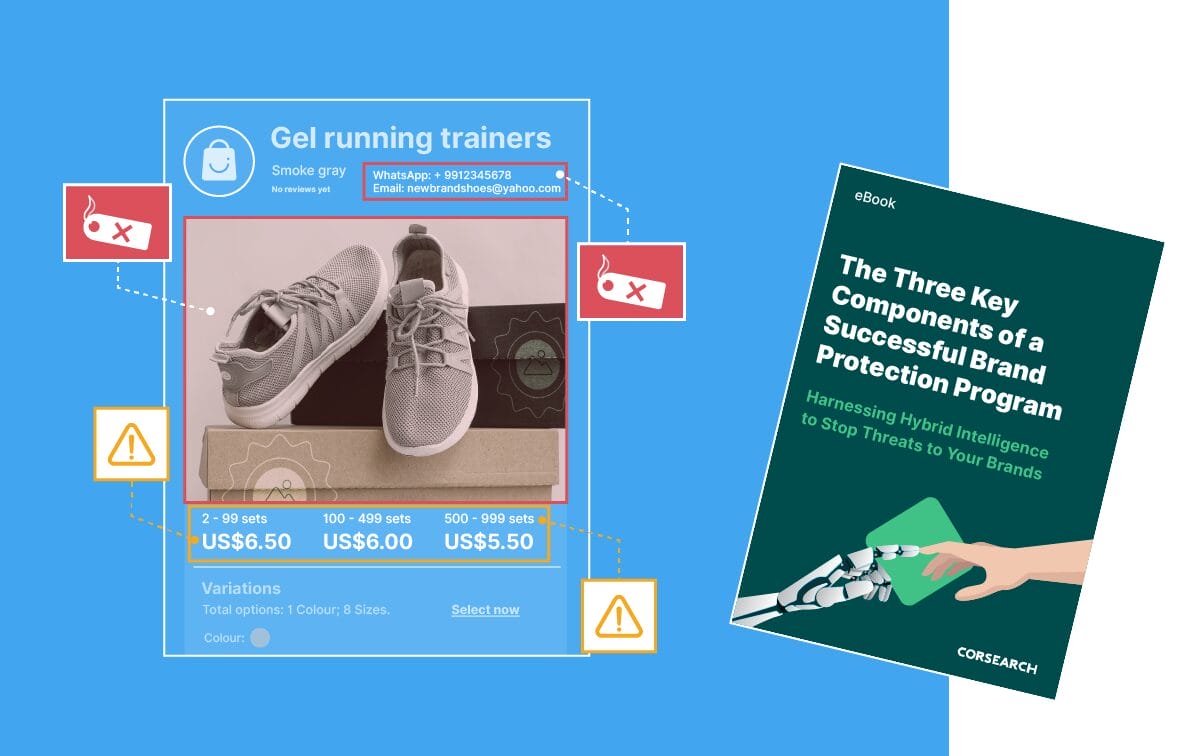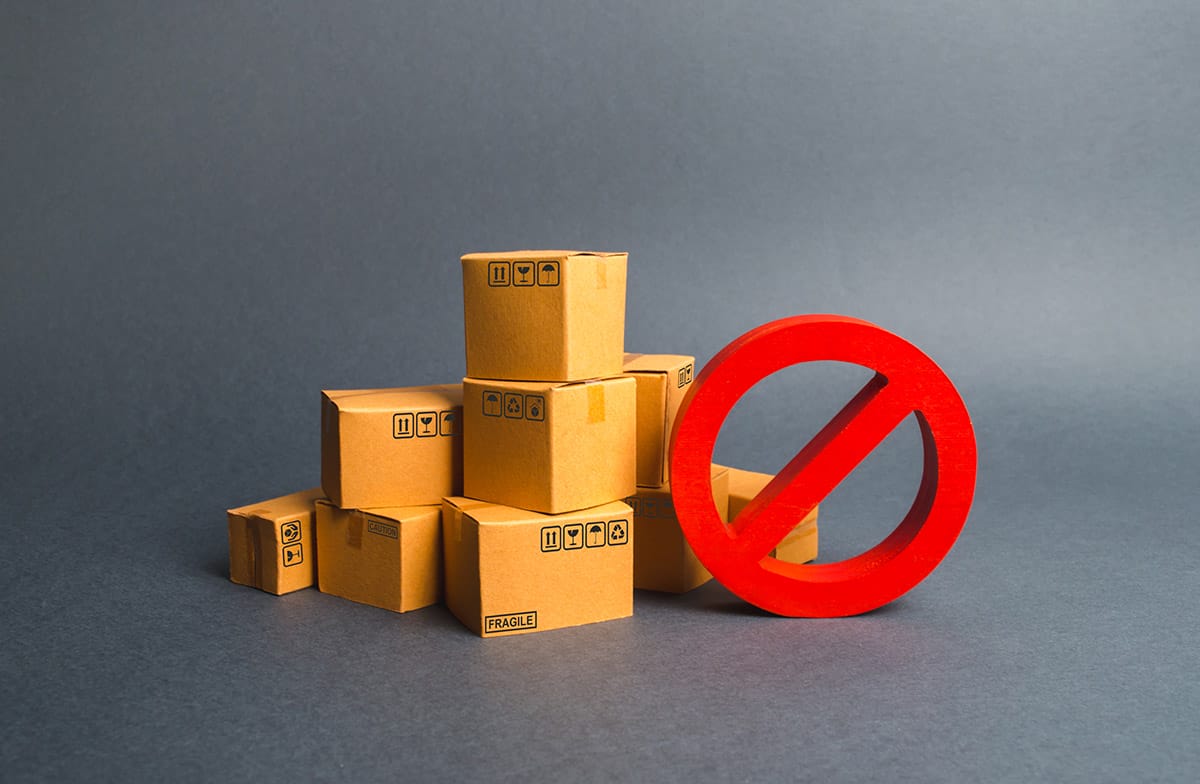Blog
Exploring the Threat Landscape: Counterfeits & Fakes
- Brand Protection

As marketplaces continue to expand and consumers invest more time on eCommerce websites and social commerce platforms, the risk posed by counterfeits rises. Brands and consumers are firmly in the sights of bad actors – and this threat will only deepen as technology such as generative AI evolves.
The size of global trade in counterfeit goods could reach a staggering $1.79 trillion by 2030, a 75% increase from that of 2023 and a growth 3.6 times higher than predicted for the global economy over the same period[1].
Our eBook, The Three Key Components of a Successful Brand Protection Program, analyzes the current threat landscape facing brands and the tools businesses can use to maintain consumer trust and brand reputation. In this blog we explore current and emerging counterfeit threats.
The impact of counterfeits on consumers and brands
It is an unfortunate truth that the stronger and more successful your brand is, the more likely it will be seen as a prized target by counterfeiters.
As showcased in our eBook, counterfeits are becoming increasingly sophisticated, making it difficult for well-intentioned consumers to distinguish between what is real and what is fake. But this doesn’t mean that they’re produced with quality components in sanitary and safe environments. Counterfeit bike helmets, for example, have been known to shatter at the slightest impact when made from inferior materials and without adherence to required industry standards. Counterfeit children’s car seats have been found to fail during safety tests, vastly increasing the risk of injury or death during a crash.
Incidents involving poor-quality and unsafe counterfeits that pass as the real thing to the untrained eye can quickly lead to an erosion of trust. Trust is a commodity in today’s world which is extremely difficult to regain.
Real world examples of counterfeit operations
Counterfeit distributor Pandabuy
Pandabuy, based in Hangzhou in China, was an eCommerce shipping operation that bridged the gap between European / US consumers and Chinese sellers on platforms that restrict international shipping – such as Taobao. It was a popular location for consumers and influencers who actively sought counterfeit luxury and designer goods, with Reddit threads, Discord channels, and TikTok posts informing others how to purchase them.
Corsearch started gathering intelligence on Pandabuy in 2022. In Fall 2023, Corsearch’s Fashion and Luxury Team noticed a significant increase in the operation’s social media presence, especially on TikTok. The team gathered evidence showing Pandabuy agents facilitating counterfeit sales and presented these findings to an affected Corsearch client, who verified the threat through their own investigation and test purchases.
Other affected brands also started investigations, which gained momentum in November 2023. Corsearch collaborated with these brands and the Police Intellectual Property Crime Unit (PIPCU) of City of London Police, who forwarded evidence to Chinese law enforcement.
In April 2024, Chinese authorities raided Pandabuy’s head office and warehouses, involving nearly 100 officers. The raid resulted in 30 arrests and the seizure of counterfeit goods worth millions, enough to fill 20 football stadiums. The operation has since shuttered, with legal action by brand owners against the perpetrators now underway[2].
Learn more about the Pandabuy investigation in articles by Bloomberg, The Guardian, and World Trademark Review.
Counterfeit Bombas socks
Bombas, a fashion brand known for its luxury socks, has been increasingly targeted by counterfeiters. These bad actors create fake websites that mimic Bombas’ official site to lure in unsuspecting customers[3]. Stephanie Lee, a mother from Virginia, fell victim to such a scam after seeing an ad on Facebook for licensed Bombas socks at a 53% discount. She was directed to a page that closely resembled the Bombas website. Convinced of the site’s legitimacy, Stephanie went on to spend $116 on multiple items of merchandise (an individual pair of licensed Bombas socks can retail at up to $120), only to grow suspicious when she didn’t receive a confirmation email.
Bombas CEO Dave Heath described the struggle against these fraudulent sites as a “game of whack-a-mole,” where each taken down is quickly replaced by another. These counterfeit sites exploit the same digital marketing tactics as legitimate businesses, including paid search and social media advertising, to deceive consumers. They capitalize on the bargain-hunting behavior prevalent during the holiday season, preying on shoppers eager for discounts.
Douglas LaGore from KPMG’s cybersecurity division noted that these scams are often orchestrated by sophisticated networks with specialized skills. One group may identify potential targets while another creates the fake websites and adverts. This coordinated approach, coined a “cyber threat supply chain,” makes it increasingly difficult for companies like Bombas to protect their brand and consumers from these deceptive practices.
How the promotion of counterfeits has evolved
Social commerce – the TikTok effect
With online shopping habits continuing to evolve, counterfeiters have flocked to social commerce and other social platforms to promote and sell counterfeits. The volume of fakes on platforms such as TikTok and Instagram should come as no surprise – it is estimated that over 62% of the globe’s population are social media users[4].
Bad actors will often post images or videos with distorted or partially covered logos to avoid detection. They will embed text within images that contains contact information or web addresses to complete transactions off-platform.
Fake reviews created with generative AI
Counterfeiters rely on fake reviews to mislead well-intentioned consumers. They can be human-generated, where individuals are paid to write positive or negative reviews, or machine-generated, using AI tools like natural language processing (NLP) and machine learning (ML) to create large numbers of reviews that appear authentic.
The emergence of generative AI tools has made it more difficult for platforms, like Amazon and eBay, to filter out fraudulent content, putting consumers at risk. However, investments are being made to combat this, with Amazon reportedly blocking over 200 million suspected fake reviews in 2022[5].
eBook: The key components of an Anti-Counterfeiting Program
Comprehensive Brand Protection and Anti-Counterfeiting programs combine three key components to deliver substantial ROI.
Use our eBook to dive deeper into the technology and expertise you’ll need to realize your strategy.

How AI can be used to fight counterfeits
To find and action the counterfeit listings that present the most risk, your team needs to harness hybrid intelligence. Leveraging advanced AI and human expertise, you can protect consumers from harm and preserve online revenue.
Our AI-fueled and expert-guided Brand Protection solutions offer:
- The broadest visibility of threats across all online channels
- Instant identification of counterfeit listings
- Enforcement with proven success
- Lasting impact to protect your brand, IP, and consumers
Learn more about the AI-assisted capabilities that will enable you to clean up priority platforms and reduce the volume of counterfeits online in part two of this blog series. Or request a demo of our technology to see our capabilities in action.
Request a 15 minute personalized demo
Our trusted and recognized status with online platforms helps us to remove illicit listings 46% faster than other vendors. Demo our technology to see why Corsearch is the right choice for you.

- 1,400 marketplaces platforms covered
- 1.3 million enforcements on platforms every month
- 99.9% compliance rate in removing infringements
- $147 million worth of counterfeit stock removed monthly for luxury fashion brands
Corsearch is trusted by:
[1] Total global trade in goods: $31 trillion (UN Conference on Trade & Development) (2023)
Total growth in global trade in goods through 2030: 2.3% (Boston Consulting Group)
Total trade in counterfeit goods, 2023: $1.023 trillion (OECD data) (2023)
[2] World Trademark Review (2024). “Willful counterfeiting” – Pandabuy target of US lawsuit by major streetwear brands: https://www.worldtrademarkreview.com/article/willful-counterfeiting-pandabuy-target-of-us-lawsuit-major-streetwear-brands
[3] New York Times (2023). With Many Retailers Offering Online Sales, Phony Sites Blend In: https://www.nytimes.com/2023/01/11/business/online-shopping-scams.html
[4] Statista (2024). Number of internet and social media users worldwide as of April 2024:
https://www.statista.com/statistics/617136/digital-population-worldwide/
[5] About Amazon (2023). “How Amazon is using AI to ensure authentic customer reviews”: https://www.aboutamazon.com/news/policy-news-views/how-ai-spots-fake-reviews-amazon





